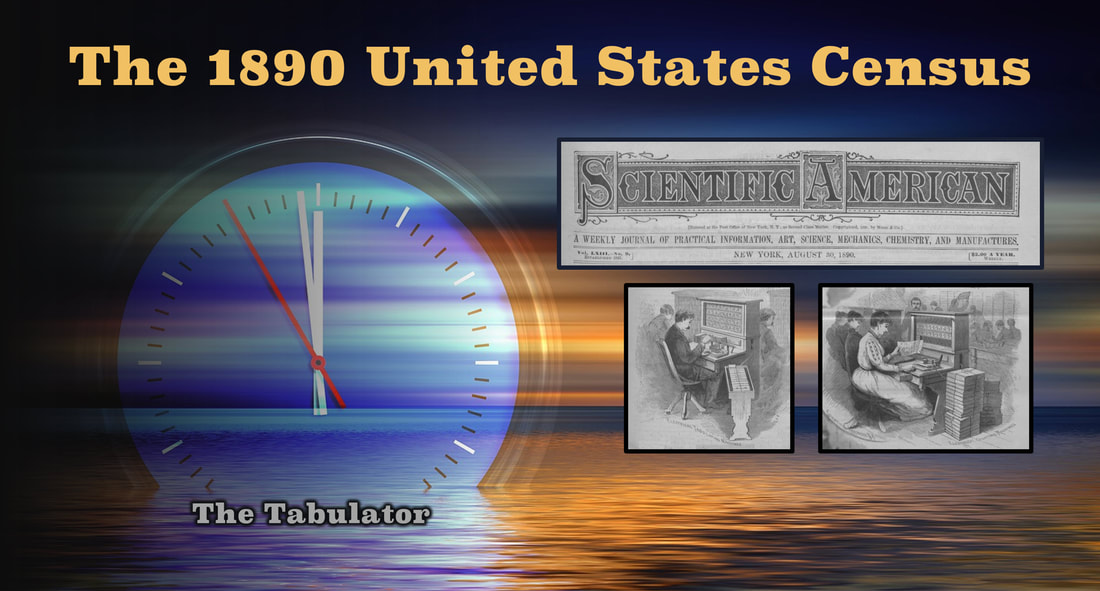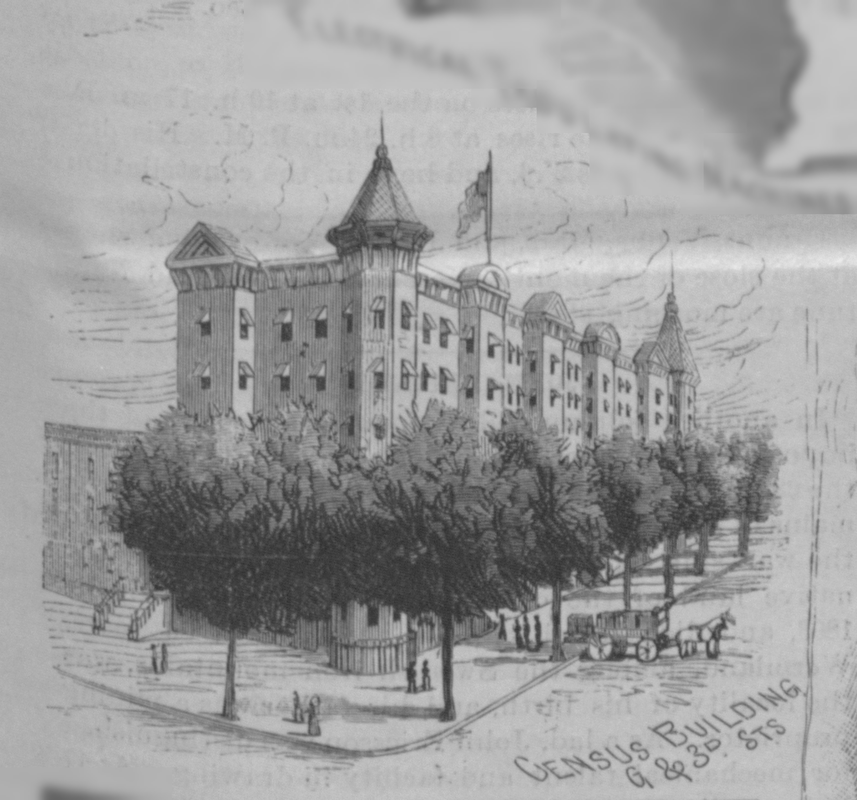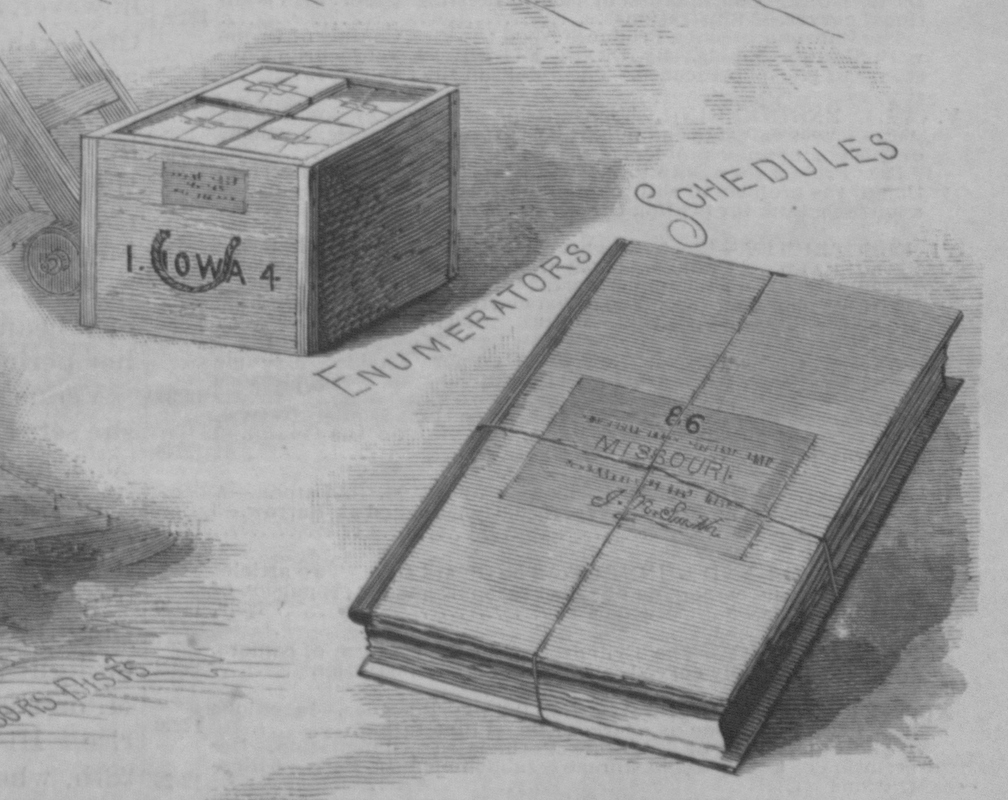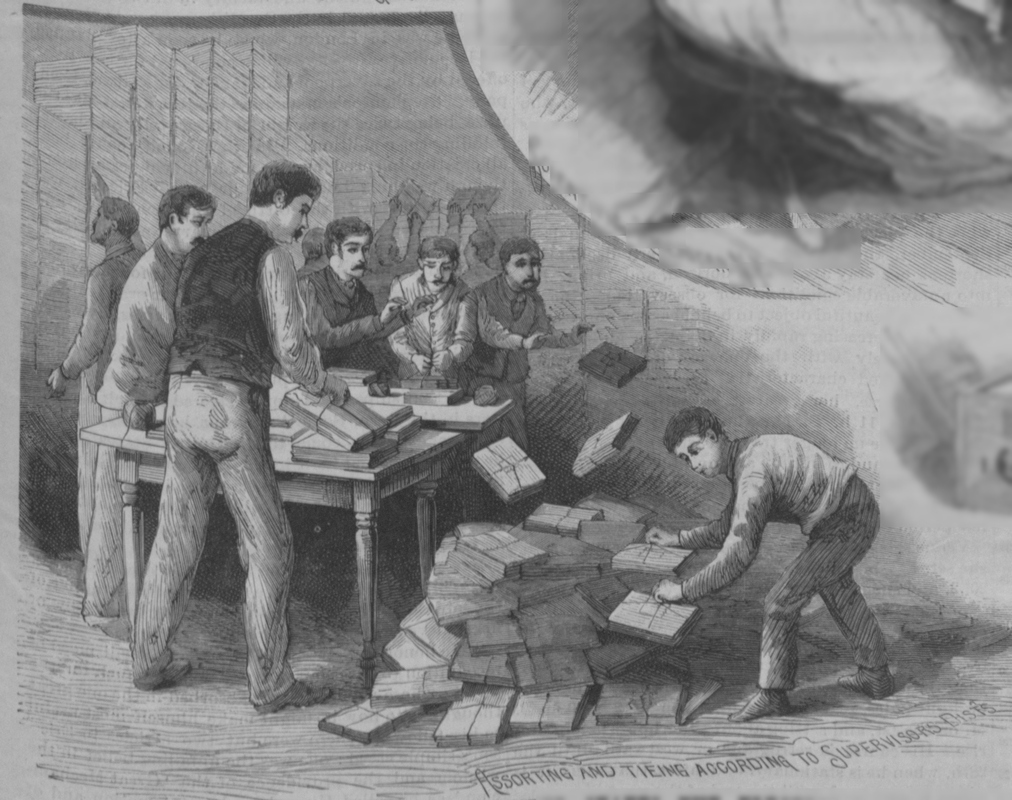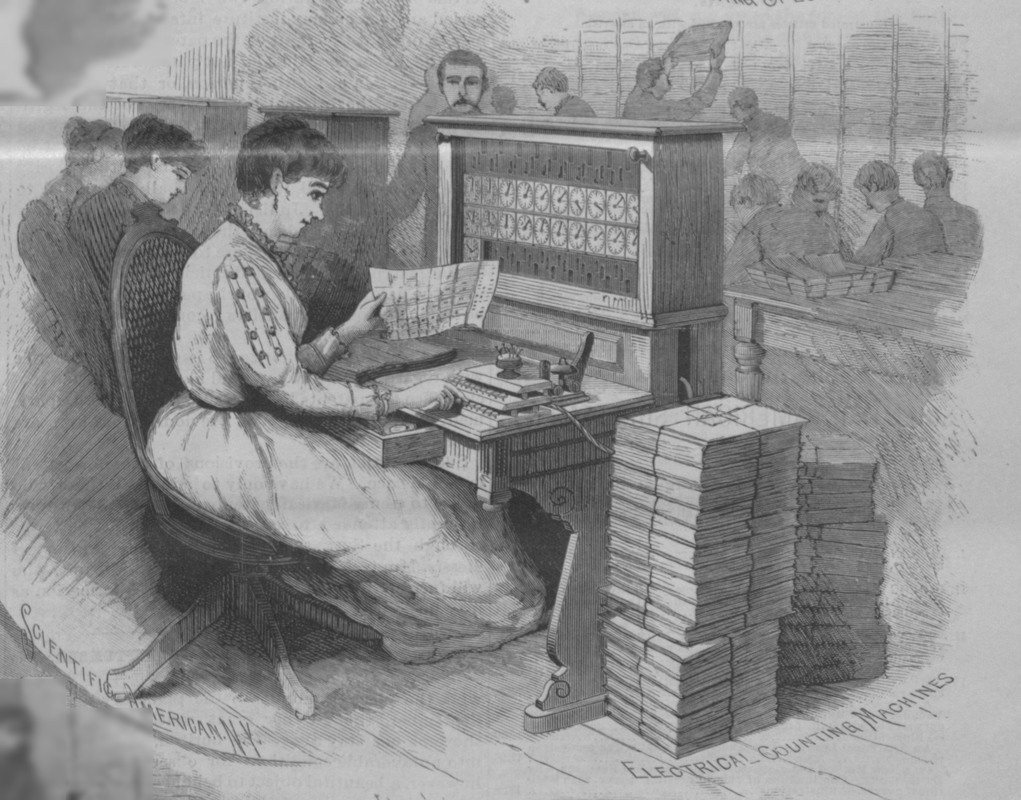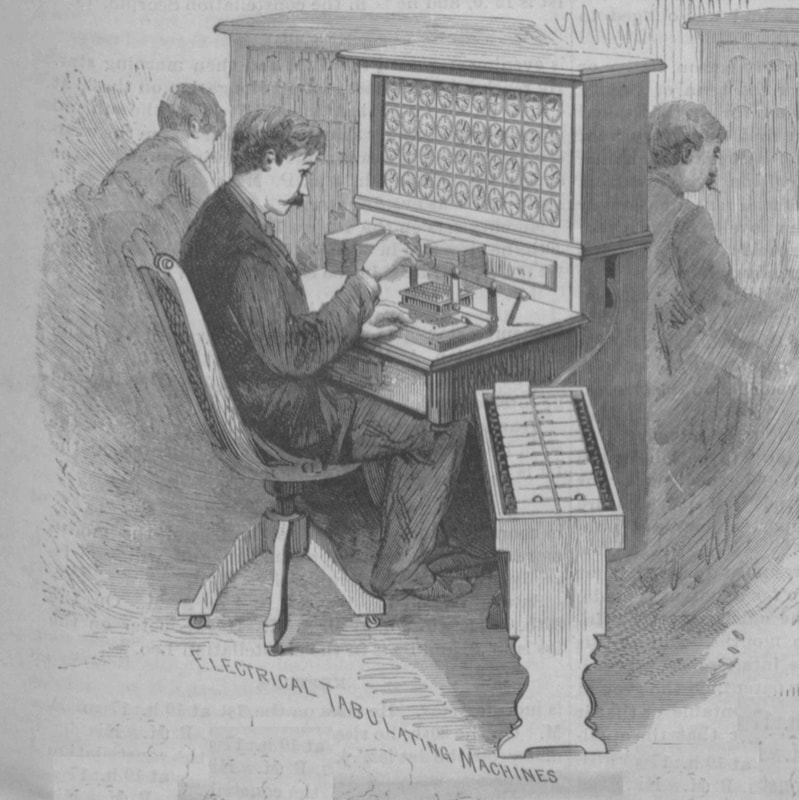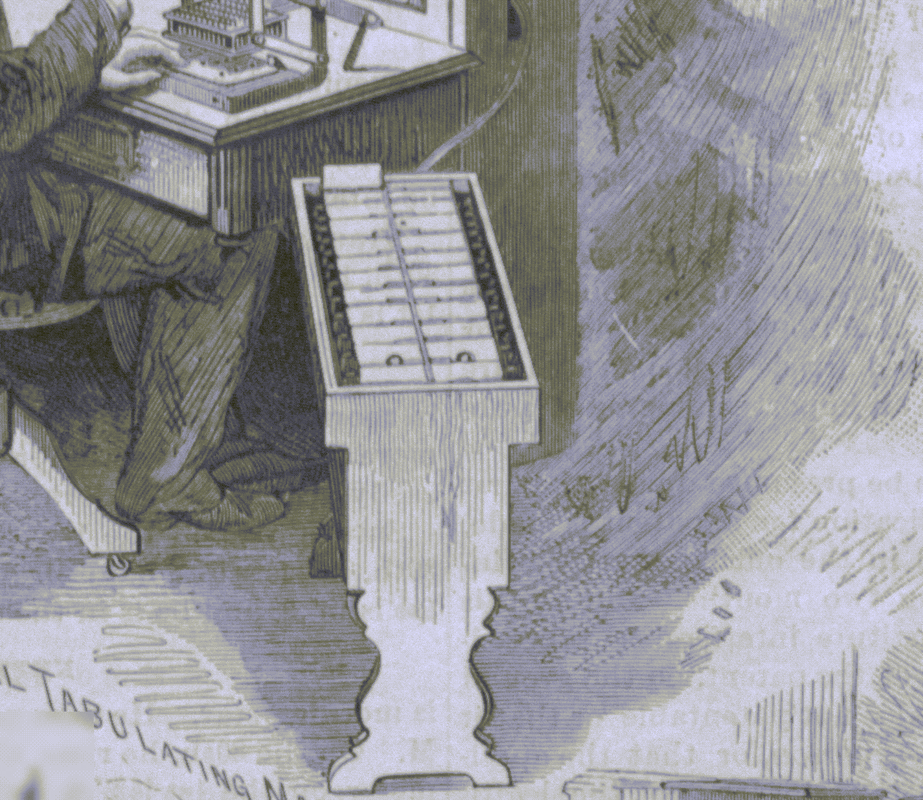Tabulating Machines of the 1890 U.S. Census
|
|
Date Published: August 11, 2021
Date Modified: June 29, 2024 |
The United States Census of 1890 was the first usage of electrical tabulating machines on a large scale. It was a gamble by Herman Hollerith that worked. The following is the story of how the census was conducted as seen through the eyes of a writer for the Scientific American.
[If you use the material or images from this article - and you can because they are in the public domain, please add a link back to this web site and give credit to the author for taking the time to find the article in a local library, scan it in, make its images usable, and edit the material to make it available to the public.]
The heading and subheadings below were added by this author and are his sole responsibility.
[If you use the material or images from this article - and you can because they are in the public domain, please add a link back to this web site and give credit to the author for taking the time to find the article in a local library, scan it in, make its images usable, and edit the material to make it available to the public.]
The heading and subheadings below were added by this author and are his sole responsibility.
The United States Census of 1890
The Desire for More Detailed Information Has Grown the Size of the Census
|
The Census Bureau Building
|
The Census Bureau of the United States for taking the general census is now busily engaged in reducing the schedules furnished by the fifty thousand enumerators, and in tabulating the results of the work done at the beginning of the present summer. The scope of the original census of former times has been amplified so as to include many particulars, and the work of recording the results is correspondingly increased.
Calculating and tabulating machinery has been brought into use to shorten the time expended in reaching the conclusion. With this aid the work is progressing with exceeding rapidity. In the mere summation of results or enumeration in gross, a single operator can dispose of 50,000 names in a day. |
Were this all that is required, the work would be completed now. But each schedule contains many particulars, as regards country of birth, age, health data, etc. Each of these headings again subdivides into a large number. Thus, under country of birth all the countries of the world are included, and under health there is a numerous list of diseases to be tabulated.
This has led to a division of the office work as regard such particulars, and special tabulations are made for a number of classes.
This has led to a division of the office work as regard such particulars, and special tabulations are made for a number of classes.
|
Gathering the Raw Data about the United States of America in 1890 Our readers are necessarily familiar with the work of the census enumerator. This work is entered on blank schedules, which he fills in with names and other data. The schedules from the enumerators from all parts of the United States were transmitted to Washington by registered mail.
Even in the packing a regular system was followed. The blanks which had been filled up were laid one upon the other on a piece of straw board. Each pile contained the schedules of a single enumerator. On top of all was placed an empty portfolio, to whose center was pasted the label with the enumerator's name and the designation of his district upon it. The bundle was then corded together and a number of such bundles, representing from 13 to 15 enumeration districts, were placed together in a box which they exactly fitted. The box, 27 inches long and about 18 inches In its other dimensions, properly closed and sealed, was sent in this shape to the Washington office.
One hundred such boxes were received daily, and several trucks were kept busy transferring them. |
The data is "transmitted" to Washington by mail.
|
Entering the Enumerators' Data from Across the Country in Electrical Counting Machines
|
The first operation was the enumeration in gross of the population of the United States, and by the same operation the enumeration of families and of their size. We illustrate the machine on which this work was done [the picture to the right]. It comprises a key board with a number or keys, numbered from 1 to 20, and upon the face of the machine in front of the operator, 21 dials. The keys work the indexes on the dials by electricity. Three tabulations were made here, one the growing number or people in the United States, another the number or families, and finally the number of families of each number of individuals from 1 to 20.
Having a schedule at hand, the operator we may assume sees in it a family of six members; he strikes upon the key number 6. This causes the hands on two of the dials to move. The hand on dial No. 6 moves forward one, indicating that there is one family of 6 members. |
The female clerks averaged about 47,000 names, against 32,000 for the male clerks.
|
The band on the odd dial moves forward 6 divisions, indicating that there are 6 individuals to be accounted for from the schedule in question. As each contact is made a bell rings. In this way the enumeration of families up to 20 members is conducted. The few families exceeding this are not provided for on the machine, and are so rare that they may, of course, be specially noted. Great dexterity is attained in the use of this machine.
It is on this that many operators attain the speed of 50,000 names per day, and the entire count of the United States has now been twice executed on machines of this type, making a total of 64,000,000 of individuals each time.
It is on this that many operators attain the speed of 50,000 names per day, and the entire count of the United States has now been twice executed on machines of this type, making a total of 64,000,000 of individuals each time.
Inputting the Census' Raw Individual Data onto Cards: The 1890's Data Input Device
|
The next operation involves a classifying of the large number or data contained on the schedules. This work is done by a system of machinery involving the use of perforated cards recalling the lace pattern cards used on lace machines. For ages, race, and all other data, such as diseases or other particulars, a card is punched for each person on the schedules. The apparatus used we illustrate, together with a representation of the punched card [shown to the right.
In front of the operator is a perforated plate, each of whose perforations has a designation marked at its side. As samples or designations, we find one set marked with numerals running from 0 to 100, with intervals of five between. These are used to designate age. On another portion of the board the 18 divisions of the earth as adopted for the uses of the census are given for the purpose of tabulating nationalities. The same system is carried out to cover all the cases that may be named upon the schedule. |
A card is punched for each person from the schedules.
|
The range and capacity of the machine may be realized from the fact that there are 240 of these apertures. A punch attached to a species of pantograph frame works above this plate. Back of the perforated plate is a place for the insertion of a card, and above the card and attached to the pantograph frame is a second punch. Thus connected to the frame, the second punch reproduces all the movements of the first punch in duplicate on a smaller scale and within the area of the card.
When the first punch nearest the operator is forced down into any hole of the perforated plate, the punch over the card is forced down through the card, making a corresponding aperture. While it is perfectly obvious that 240 such apertures might be made on a single card, it is equally clear that this never could be required. Thus, a person would only be referred to one race, and only a single age number could be tabulated, the same holding for other data, so that as carried out about 18 or 20 perforations are made in each card.
On the upper corner of the cut will be seen the picture of a perforated card. A skilled operator can read off one of these cards as if it were a book. It tells him if the person referred to is white or black ; it tells the age, where born, if literate or illiterate, etc. But as this degree of skill is not to be expected from everyone, templates are provided in which the perforated card can be laid, and the results read through the apertures.
In their regular use such reading is unnecessary: The cards are used for tabulating results automatically.
When the first punch nearest the operator is forced down into any hole of the perforated plate, the punch over the card is forced down through the card, making a corresponding aperture. While it is perfectly obvious that 240 such apertures might be made on a single card, it is equally clear that this never could be required. Thus, a person would only be referred to one race, and only a single age number could be tabulated, the same holding for other data, so that as carried out about 18 or 20 perforations are made in each card.
On the upper corner of the cut will be seen the picture of a perforated card. A skilled operator can read off one of these cards as if it were a book. It tells him if the person referred to is white or black ; it tells the age, where born, if literate or illiterate, etc. But as this degree of skill is not to be expected from everyone, templates are provided in which the perforated card can be laid, and the results read through the apertures.
In their regular use such reading is unnecessary: The cards are used for tabulating results automatically.
Transforming the Census' Raw Data into Useful Information
|
The apparatus used for that purpose we also illustrate [picture to the right]. A frame holding a number of descending points corresponding with a certain number only of the 240 possible apertures of a single card is arranged so as to be raised or lowered by a handle. When depressed, the points come in contact with mercury cups, one below each point, making electric contact, and each thereby causes the movement of the index of a specific dial. Thus, when depressed, each of the indexes corresponding to the contact points in use would move forward one division.
If, before pressing the handle, an unperforated card was introduced, none of the contacts could be made, and none of the indexes would move. If, however, a perforated card is introduced, wires will descend through such of the perforations as correspond with the contact points in use, and contacts will be made corresponding to the perforations in the card, and the indexes corresponding thereto will move forward one division. |
Tabulating machine and assorting
device in operation. |
Thus, a single depression of the handle, the card being placed, causes its story to be transmitted in whole or in part to the case of dials seen facing the operator. It would be manifestly impracticable to make a single machine of sufficient capacity to include all the tabulations possible. It is here that the specializing system comes into play. A tabulating machine may be, and in practice is always, restricted by the omission of a portion of the contact points to a narrow range of subjects.
As in use at the census bureau, the machine has forty dials, and at most only forty data [points] can be provided for on each.
A box divided into compartments may be noticed at the side of the operator [the picture above]. This has lids to its many compartments. which are opened by electricity. As the operator presses the handle, one of the electrical connections, it may be that referring to race or any other desired particular, causes a special compartment of the box to open for the reception of the card just tabulated. Thus, the cards are classified for transmission to succeeding machines.
As in use at the census bureau, the machine has forty dials, and at most only forty data [points] can be provided for on each.
A box divided into compartments may be noticed at the side of the operator [the picture above]. This has lids to its many compartments. which are opened by electricity. As the operator presses the handle, one of the electrical connections, it may be that referring to race or any other desired particular, causes a special compartment of the box to open for the reception of the card just tabulated. Thus, the cards are classified for transmission to succeeding machines.
|
The machines, it will be seen, go no further than to record upon dials. The results, it is obvious, may, at the close or each day, be entered in books from the dials. It will be noticed that the power of introducing or omitting contact points gives the tabulating machines a very large range. This is still further increased by the assorting case [pictured to the right], with its twenty-six lids automatically opened or shut by certain contacts.
This enables a single machine to sort out cards for as many succeeding machines as there are lids to the case. The same elasticity of function applies to the tabulation of the special schedules. A great number of these are to be treated, and the greatest variety of requirements is embodied in the execution of the operations. |
The assorting case is a powerful addition.
|
The 1890 Census Combines the Power of Mechanical and Electrical Ingenuity
The work of this census is the first ever executed by electricity. In the mere enumeration in gross 15,000,000 schedules were twice gone over. The count proper began on July 1 and in six weeks the names were counted twice. The figure of 50,000 names per day was reached on one day by forty-three operators. One operator, a lady, reached the total of about 80,000 names. The female clerks averaged about 47,000 names, against 32,000 for the male clerks. The magnitude of the work may be inferred from the fact that some four thousand employees are engaged in tabulation results and executing the other operations of the census.
It is estimated that the population or the world, if scheduled, could be counted by the United States census office in 200 days.
The early completion of the count was due to the improved appliances by which it was executed. The tabulation of results from the general and special schedules will be still more facilitated by the electric machinery. It lends itself to all modifications of data, and owing to it, it is hoped that the results will be reached and printed in half the time required for the last census. The apparatus was invented by Mr. Herman Hollerith, of Washington, D. C. To a mechanical and electrical inventor, the accuracy and early completion of the census work is in great part due, illustrating an interesting alliance of the abstract and concrete.
It is estimated that the population or the world, if scheduled, could be counted by the United States census office in 200 days.
The early completion of the count was due to the improved appliances by which it was executed. The tabulation of results from the general and special schedules will be still more facilitated by the electric machinery. It lends itself to all modifications of data, and owing to it, it is hoped that the results will be reached and printed in half the time required for the last census. The apparatus was invented by Mr. Herman Hollerith, of Washington, D. C. To a mechanical and electrical inventor, the accuracy and early completion of the census work is in great part due, illustrating an interesting alliance of the abstract and concrete.
Scientific American, August 30, 1890
